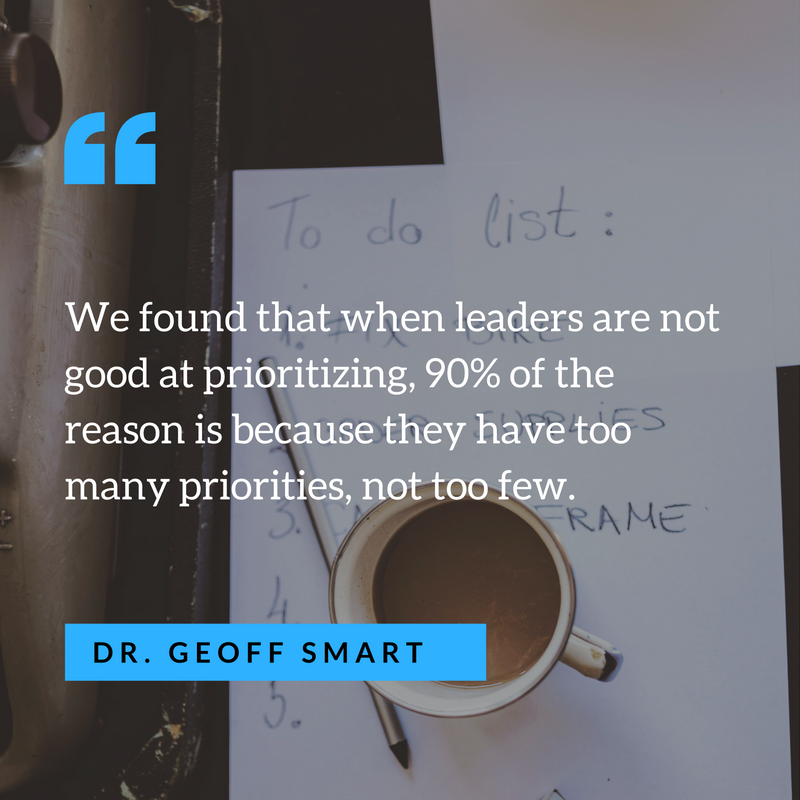Most leaders struggle to prioritize.
In the research we did for Power Score, which included 9 million data points on successful and unsuccessful careers, we discovered that only 24% of leaders are rated as good at prioritizing.
No wonder so many employees are confused!
No wonder so much money gets wasted on things that don’t matter!
No wonder people feel so stressed out—and feel like they are juggling too many balls at once.
Here is another important finding. So the trick to becoming good at prioritizing is to figure out how to narrow down the number of priorities to the two or three that matter most.
How to set a small number of the right priorities?
There are bad ways to set priorities:
- Going with the first good idea that a team comes up with, without considering alternatives.
- Letting the loudest mouth in the room dominate the discussion with his or her pet priorities.
- Out of fear of telling someone “no,” agreeing to too many priorities.
And there are several good ways to set priorities:
- To discuss and come up with a long laundry list of potential priorities.
- To debate the costs and benefits of each, as well as their link to the organization’s overall strategy, brand, and purpose. We often talk about what is “on brand” or “off brand” for ghSMART, and it matters as we debate whether a priority is worth doing.
- The very best practice for deciding on priorities is this. Use a simple formula you learned in Econ 101: expected value.
Remind me, what’s expected value again?
Expected value just means how much value you think you are going to receive from doing something, given the probability it will happen and the value if it happens.
EV = P x V.
For example, if I told you that you can keep an American quarter if you flip it and it comes up “heads,” the expected value of that transaction is 50% x $0.25 = $0.125.
So what does that have to do with helping us set priorities for our team?
Check this out. Let’s say your team comes up with this list of possible priorities for next year: Re-do Website, Create SMB Product, Open a London Office, Free Sushi Lunches, Digitize Intellectual Property, Try to Clone Elena, or Launch Candy Bar Product.
Your next step is to say, “Let’s rate the probability we could achieve those priorities.” The team ratings come in like this: London 10/10; Sushi 10/10; Website 9/10; Digitize 8/10; Candy 3/10; SMB 3/10; Clone 1/10.
After that, you say, “Let’s now rate the value of each priority, if we achieved it.” The team ratings come in like this: Digitize 10/10; Clone 10/10; London 9/10; SMB 3/10; Candy 3/10; Website 2/10; Sushi 1/10.
Finally, you multiply the two numbers together and rank them from highest to lowest priority. And voila!
Team Priorities for Next Year
|
Priority |
Probability |
Value |
Expected Value |
|
| 1 | Open London Office | 10 | 9 | 90 |
| 2 | Digitize Intellectual Property | 8 | 10 | 80 |
| 3 | Re-do Website | 9 | 2 | 18 |
| 4 | Clone Elena | 1 | 10 | 10 |
| 5 | Free Sushi Lunches | 10 | 1 | 10 |
| 6 | Launch Candy Bar Product | 3 | 3 | 9 |
| 7 | Create SMB Product | 3 | 3 | 9 |
How clear is that! Deciding on the right priorities could not be easier.
Based on the probability of success, and the value of succeeding, this team should definitely open a London office and digitize intellectual property. Those priorities scored a 90 and an 80. The rest of the priorities really drop off in expected value, so they should skip them.
One more factor is useful— “urgency.” A priority might have a high probability of success, and a high value, but not be as time urgent as other priorities. Two more factors matter to me, if I’m the one who is going to be executing the priority—to what extent that priority fits into my “skill” (something I can do) and “will” (something I want to do).
Bottom line is this. You will be more powerful as a leader if you allocate scarce time to the priorities that have a high probability of success, high value, high urgency, and that also for you fit your skill-will bullseye. Rate and rank ’em. Then just do the top ones. Don’t do the less high priorities, or delegate, or delay them.
And if you think these tactics are useful, please download our other free leadership tools at SMARTtools for Leaders™.

Leave a Reply